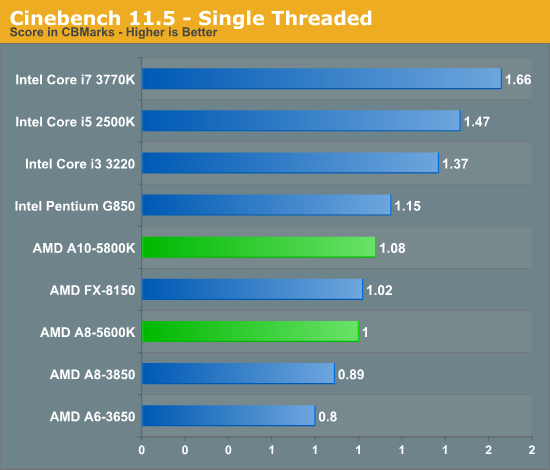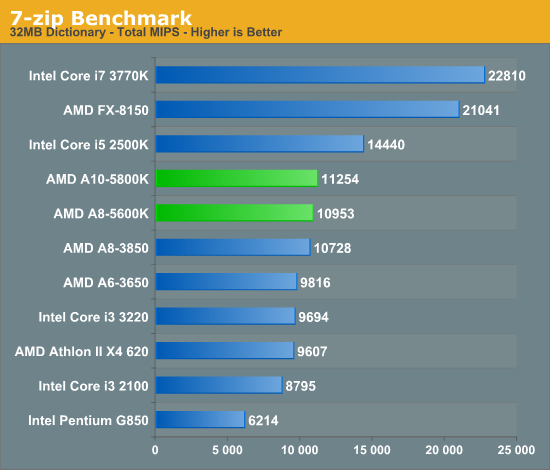AMD A10-5800K & A8-5600K Review: Trinity on the Desktop, Part 2
by Anand Lal Shimpi on October 2, 2012 1:45 AM ESTTrinity CPU Performance: The Good and the Bad
We're going to start our performance investigation a little out of order. The big question on everyone's mind is how much single threaded performance has improved over Bulldozer, and whether it's enough to actually make Trinity faster than Llano across the board. We'll use Cinebench 11.5 as it has both single and multithreaded test options:

The good news is that single threaded performance is definitely up compared to Llano. Piledriver likely has some to do with this, but so does the fact that the A10 can run at up to 4.2GHz (~4GHz typically) with one of its cores active compared to the 2.9GHz clock speed of the A8-3850. Compared to the Bulldozer based FX-8150 there's a slight (~6%) increase in single threaded performance. Although I don't expect anyone will be cross shopping a Trinity APU and a FX CPU, it's important to keep an eye on progress here as we'll eventually get a high-end quad-module/eight-core Piledriver CPU.
Note that compared to even previous generation, low-end Intel CPUs without turbo there's a huge gap in single threaded performance. If we look at the gap AMD has to make up vs. Ivy Bridge it's not pretty. Intel's Core i3 3220 manages a 27% performance advantage over the A10-5800K. Even if Steamroller is able to deliver a 15% increase in performance at the same clock speed, there will still be a gap. And we're not even talking about how Haswell will grow this gap. For the foreseeable future I don't see AMD closing the single threaded performance gap. Jim Keller's job is to fix this problem, but it'll probably take 2 - 3 years to get there.

The multithreaded test shows the other end of reality: in heavily threaded foating point workloads it's possible that we'll see a regression compared to Llano. Remember the Bulldozer/Piledriver architecture prioritizes integer over floating point performance. Truth be told this regression is pretty rare in our tests, but until we get to Steamroller we will still see these types of situations.
Throw more threads at the problem and even with a floating point workload Intel can't pull ahead however. The A10 offers similar performance to the Core i3 3220 at a lower price. Your decision here would come down to the rest of the factors: single threaded performance, processor graphics performance, overclocking capabilities and power consumption. Intel and AMD both win two of those each, it's really a matter of what matters most to you.
A heavily threaded FP workload doesn't really play to AMD's advantages though, what happens when you get a heavily threaded integer workload however? The 7-zip benchmark gives us just that:

Here AMD manages a 16% performance advantage over the Core i3 3220. I'd even go as far as to say that Trinity would likely beat any dual-core Intel machine here. The performance advantage is somewhat artificial as Intel purposefully removes turbo from its dual-core desktop CPUs. This should be AMD's best foot forward, but once again it'll likely take Steamroller for this design to start to make sense.
Speaking of artificial product segmentation, one major feature Intel takes away when you get down to the dual-core desktop i3 level is AES-NI support. Hardware accelerated AES support is something that you get only with the more expensive Core i5/i7s. With Trinity, you get AES-NI support for the entire stack. The result is much better performance in those applications that depend on it:

Like most of the advantages we've talked about thus far, there are really very specific use cases where Trinity makes sense over a similarly priced Intel CPU.










178 Comments
View All Comments
Crono - Tuesday, October 2, 2012 - link
It's good to finally see pricing on Trinity.Looks like AMD is still competitive at lower price points for Video transcoding performance, which is good news for me and others who's highest CPU workloads are mostly video editing.
But even for gaming the A10-5800/K doesn't look too bad for $122 chips.
Glad to see it isn't quite "Bulldozer" all over again. I need to build a new system for Windows 8 and Trinity looks promising for a budget to mid range build.
ac2 - Tuesday, October 2, 2012 - link
Big deal...Just look at pg 2, the single threaded performance of the A10 is lower than a friggin Pentium G850
Pg 3 Sysmark, only slightly ahead of the Pentium even with 2 additional Integer cores
I wish Anand had included the Pentium G850 power comparison as well though at 65W vs 100W TDP we can be sure which way that will swing...
And the G850 costs a little more than HALF the A10 suggested price... That puts a $70 saving towards a discrete graphics card, which, as per pg 6 should result in a much better gaming performance as well...
StevoLincolnite - Tuesday, October 2, 2012 - link
It's also slower than an old Core 2 Quad Q6600 overclocked to 3.6ghz+ which was released in 2007 both in single threaded and multi-threaded tasks.However, what I would like to see is some under-volting tests to see how low they can go in terms of TDP as AMD has always been incredibly conservative (Even on the GPU side) with voltages, would be excellent in a Mini-ITX rig without the need for a dedicated GPU.
MrMilli - Tuesday, October 2, 2012 - link
http://www.computerbase.de/artikel/prozessoren/201...Belard - Tuesday, October 2, 2012 - link
Really cool how the performance charts are NOT static.Ah, German technology. :)
phillock - Friday, January 26, 2018 - link
I think there is very little need for raw single-threaded performance increases in consumer-level "general computation" processors (e.g. few-core x86 processors). So who cares if we don't have a second intel? What we do need are better ways of extracting performance from multiple cores, and from the massively parallel architectures found in GPUs. Part of the equation is ensuring that these two paradigms are pervasive, and therefore,https://audiomanagerapp.wordpress.com/2017/10/11/a... from a big-picture point-of-view, AMD really *is* pushing things forward with TrinityB3an - Tuesday, October 2, 2012 - link
Trinity truly is embarrassingly slow. I think it should be even cheaper for this performance level. And it's also disappointing that Intel have no performance competition AT ALL from AMD. We need this for some real progression to be made in desktop CPU's and also drive prices down at the high end.IKeelU - Tuesday, October 2, 2012 - link
What kind of progress are you talking about? Power efficiency? Raw general computing performance? Progress comes in many forms.I think there is very little need for raw single-threaded performance increases in consumer-level "general computation" processors (e.g. few-core x86 processors). So who cares if we don't have a second intel? What we do need are better ways of extracting performance from multiple cores, and from the massively parallel architectures found in GPUs. Part of the equation is ensuring that these two paradigms are pervasive, and therefore, from a big-picture point-of-view, AMD really *is* pushing things forward with Trinity.
Belard - Tuesday, October 2, 2012 - link
AMD's progress is about 2 years behind. While this is somewhat intel's fault by illegal competitive practices which in turn kept AMD from profiting as much as they could have during the Athlon64~X2 era.AMD has done a lot of things wrong and would take at least 2 years to sort out... if ever. FM2 is no better than FM1 and not cross compatible. Neither is compatible with Socket AM3 and nothing AMD has on the market even supports PCIe 3.0.
Compared to buying an intel i3-something system, in which you can upgrade to an i7-something easily. AMD has a mess on their hands and I suspect part of their performance problems could also be rooted in their chipsets. (Across the board, the performance hits a wall). Yeah, for a notebook - the powerful GPU part comes into play. And both intel i3 and Trinity is more than powerful enough for MOST people. hell, I'm still running on a Q6600 at 2.4Ghz and it does quite well (going i5-3570 this weekend)... But for those who want their money's worth when performance counts, AMD is not in the game.
The performance from AMD has to be consistent, and its not. The heat is not good along with the cheap fans they include that are noisy and should be replaced with a good $20~50 cooler. Meanwhile intel CPUs are running cooler and their fans are very quiet.
So as of today, in general - it costs more to get an AMD. I really want AMD to do well, I've sold lots of AMD systems in the past.
Origin64 - Wednesday, October 3, 2012 - link
About PCIe 3.0, nobody needs that. 2.0 * 8 is enough to drive every card on the market with maybe 2% performance loss, which is within the error margin of every benchmark. To keep prices low, of course they're not going to add extra features that nobody needs. I think it's a smart move.Other than that, I agree. AMD hasn't been doing well price-performance wise the last two years. I have a Phenom II, and when they were released they were still competitive, for the price and the time, but the last two generations have seen no singlethreaded performance increase and cost about the same.